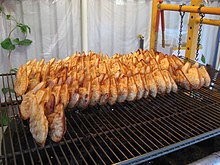Bungeo-ppang
| Bungeo-ppang | |
 Bungeoppang being sold in Toronto. | |
| Korean name | |
|---|---|
| Hangul | |
| Revised Romanization | bungeoppang / ingeoppang (NK: ringeoppang) |
| McCune–Reischauer | pungŏ ppang / ingŏ ppang (NK: ringŏ ppang) |
Bungeoppang (lit. “crucian carp cake/bread”) is the Korean name of Taiyaki.
Bungeoppangs are made using an appliance similar to a waffle iron. The batter is poured into a fish-shaped mold, red bean paste is added, then more batter to encase the red bean paste. The mold is then closed, and roasted.[2]
In Korean, bung'eo (붕어) means Carassius, a kind of fish, and ppang (빵) means bread.
Bungeoppang is sold as a snack by open-air food vendors throughout Korea during winter. In 2009, one U.S. dollar could purchase four or five bungeoppangs, depending on the location.
There are also bungeoppang-shaped waffles filled with ice cream and pat (sweetened and boiled red beans or azuki beans). These waffles are usually mass produced and sold by retailers, not by open-air food vendors.

Similar variations also exist:
- Gukhwappang (국화빵, “chrysanthemum cake”) is essentially identical to bungeoppang, only it is a flower-shaped pastry.
- gyeranppang (계란빵, lit. “chicken egg cake”) is filled with egg and it has a shape of rounded rectangle.
References
- ^ Martin, Samuel E. (1992). A Reference Grammar of Korean (1st Edition ed.). Rutland and Tokyo: Charles E. Tuttle Publishing. p. 95. ISBN 0-8048-1887-8.
līnge
{{cite book}}:|edition=has extra text (help) - ^ Goldberg, Lina "Asia's 10 greatest street food cities" CNN Go. 23 March 2012. Retrieved 2012-04-11
